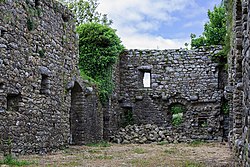Rathumney Castle
| Rathumney Castle | |
|
County Wexford | |
|---|---|
 Within Rathumney Castle | |
| Type: | hall house |
| Location | |
| Grid reference: | S76871645 |
| Location: | 52°17’43"N, 6°52’28"W |
| Village: | Rathumney |
| History | |
| Built early 13th century | |
| Information | |
| Owned by: | Heritage Ireland |
Rathumney Castle is a 13th century hall house in County Wexford, and which is also now scheduled as a National Monument.
Rathumney Castle is located in the Barrow Valley in southern County Wexford, three miles east of Campile.[1]
History
Rathumney is a hall house rather than a full castle. It is believed to have been built by the Prendergasts (descendents of Maurice de Prendergast) in the early 13th century. It served as a Cistercian grange house for nearby Tintern Abbey. The Barry family leased the grange in the 14th–15th centuries; this was common at the time, as the Cistercians had fewer lay brothers and the granges were free of tithes.
After the Cromwellian confiscation Rathumney became untenanted. Later owners were the Alcock, Colclough, Prendergast families and the current owners of the land are Foleys. They claim that King James II stayed at Rathumney on 2 July 1690 on his way to Duncannon, whence he departed to France, never to return.[2]
Building
The centre of the building was a two-storey hall, with fireplaces, tall windows and doorways.[3] The ground floor had kitchens, servants' quarters and storerooms, while the upper floor was for the noble family. The house was built of granite, shale and conglomerate. All the interior walls and worked stone have been removed. The overall floor area is measured 1,572.6 sq ft (146.1 m²).[4] at The house is surrounded by a bawn and a tower in the southeast corner had stairs and a garderobe.[5]
References
- ↑ "Rathumney Castle, Wexford". http://www.megalithicireland.com/Rathumney%20Castle,%20Wexford.html.
- ↑ "Archaeology - Cistercian Grange at Rathumney, County Wexford, Ireland". http://www.ancient-egypt.co.uk/Cistercians/Rathumney/index.htm.
- ↑ Archer, Lucy; Smith, Edwin (1 January 1999). "Architecture in Britain and Ireland, 600-1500". Harvill Press. https://books.google.ie/books?id=_flPAAAAMAAJ&q=%22Rathumney%20castle%22&dq=%22Rathumney%20castle%22&hl=en&sa=X&ved=0ahUKEwi-5tCQxI_PAhUBJ8AKHcvYB3YQ6AEIIzAB.
- ↑ "Archaeologia Cambrensis". W. Pickering. 1 January 1912. https://books.google.ie/books?id=WqBJAQAAMAAJ&dq=%22Rathumney%20castle%22&focus=searchwithinvolume&q=%22Rathumney%22.
- ↑ "Rathumneycastle". http://irishantiquities.bravehost.com/wexford/rathumney/rathumneycastle.html.
- McCord, Margaret and Rigby, Graham: 'Tower houses and ten pound castles' (Crannog P.) via Google Books}
- 'Clare Genealogy: The O'Davorens of Cahermacnaughten, Burren, Co. Clare'